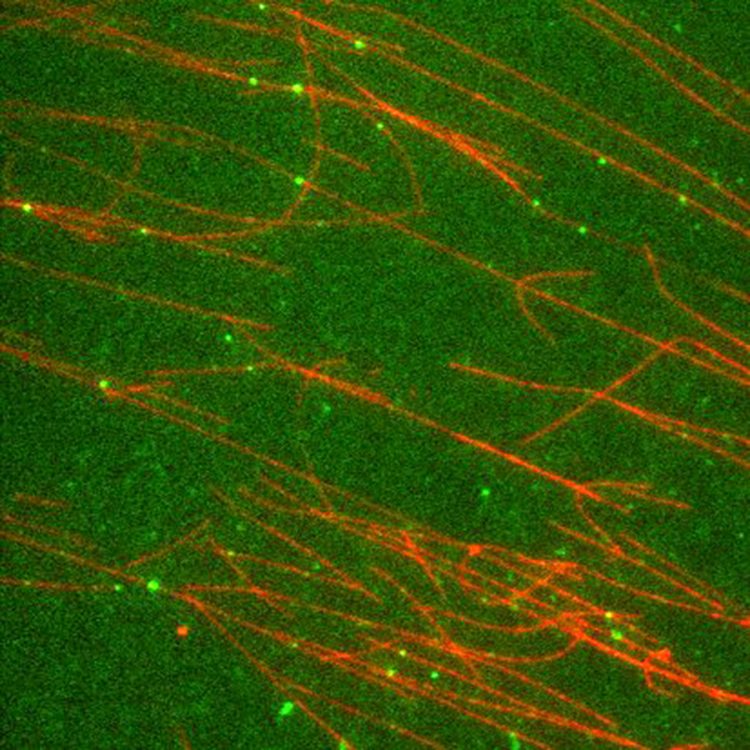Research team reconstructs motor-cargo complex for ciliary transport: How to start a nanomotor?

Motor proteins (green dots) move along microtubules like on a highway. Image: G. Merck / TUM
Flagellates need them to move, roundworms to find food, and sperm to move towards the egg: cilia. These excrescences of eukaryotic cells even ensure that the human heart ends up in the right place – cilia control the organ development of the growing fetus. “This Multifunctionality is absolutely fascinating,” says Dr. Zeynep Ökten, biophysicist in the Physics Department of the Technical University of Munich.
Only in recent years the significance of cilia for signal transduction has been recognized. “To date, we know very little about which biochemical processes control the various functions. This makes understanding the basic mechanisms even more important,” emphasizes the scientist.
Green dots in the focus
The scientist holds a glass plate with thin, liquid-filled capillaries up to the light. There is not much to see – merely a clear and transparent liquid. Only under a fluorescence microscope does the movement of compounds marked with dye become visible: green dots, all striving in one direction.
As if on a highway, the transport proteins migrate along the thin channels of the cilia. But just how these engines are started up, remained a mystery until now. That is why Zeynep Ökten and her team decided to reconstruct the protein complex.
Bottom-up instead of top-down
The building blocks of the protein complex stem from the model organism of the Caenorhabditis elegans nematode. It uses its cilia to find food and detect hazards. The biologists have already identified dozens of proteins that affect the function of nematode cilia.
“Here, the classical top-down approach reaches its limits because too many building blocks are involved,” explains Ökten. “To understand the intra-flagellar transport, IFT for short, we thus took the opposite approach, studying individual proteins and their interactions from the bottom up.”
The needle in a protein haystack
The work resembled the proverbial search for the needle in a haystack. A variety of molecular compounds came into question. After months of experimentation, the researchers stumbled upon a minimal combination of four proteins. As soon as these proteins fuse into a complex, they begin migrating through the capillaries of the sample carrier.
“When we saw the images of the fluorescence microscope, we immediately knew: Now we have found the parts of the puzzle that start the engine,” recalls Ökten. “If just one of these components is missing, due to a genetic defect, for example, the machinery will fail – which, because of the cilia’s importance, is reflected in a long list of serious diseases.”
Publication:
Mohamed A. A. Mohamed, Willi L. Stepp and Zeynep Ökten
Reconstitution reveals motor activation for intraflagellar transport
Nature, vol. 557, p 387–391 (2018) – DOI: 10.1038/s41586-018-0105-3
https://www.nature.com/articles/s41586-018-0105-3
Further information:
The work was funded by the European Research Council and the German Research Foundation (DFG) as part of the Cluster of Excellence Munich Center for Integrated Protein Science (CIPSM).
Contact:
Dr. Zeynep Ökten
Department of Physics, E22
Technical University of Munich
James-Franck-Str. 1, 85748 Garching
Tel.: +49 89 289 12885 – E-Mail: zoekten@ph.tum.de
Web: http://bio.ph.tum.de/home/dr-oekten/oekten-home.html
https://www.tum.de/nc/en/about-tum/news/press-releases/detail/article/34794/ Link to the press release
https://mediatum.ub.tum.de/652209?show_id=1447277 Video Motor proteins
Media Contact
All latest news from the category: Life Sciences and Chemistry
Articles and reports from the Life Sciences and chemistry area deal with applied and basic research into modern biology, chemistry and human medicine.
Valuable information can be found on a range of life sciences fields including bacteriology, biochemistry, bionics, bioinformatics, biophysics, biotechnology, genetics, geobotany, human biology, marine biology, microbiology, molecular biology, cellular biology, zoology, bioinorganic chemistry, microchemistry and environmental chemistry.
Newest articles

NASA: Mystery of life’s handedness deepens
The mystery of why life uses molecules with specific orientations has deepened with a NASA-funded discovery that RNA — a key molecule thought to have potentially held the instructions for…

What are the effects of historic lithium mining on water quality?
Study reveals low levels of common contaminants but high levels of other elements in waters associated with an abandoned lithium mine. Lithium ore and mining waste from a historic lithium…

Quantum-inspired design boosts efficiency of heat-to-electricity conversion
Rice engineers take unconventional route to improving thermophotovoltaic systems. Researchers at Rice University have found a new way to improve a key element of thermophotovoltaic (TPV) systems, which convert heat…



